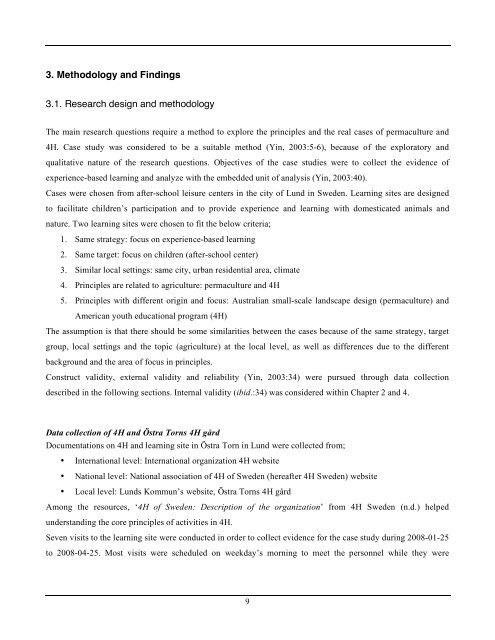Principles and Practices of 4H and Permaculture - lumes
Principles and Practices of 4H and Permaculture - lumes
Principles and Practices of 4H and Permaculture - lumes
Create successful ePaper yourself
Turn your PDF publications into a flip-book with our unique Google optimized e-Paper software.
3. Methodology <strong>and</strong> Findings3.1. Research design <strong>and</strong> methodologyThe main research questions require a method to explore the principles <strong>and</strong> the real cases <strong>of</strong> permaculture <strong>and</strong><strong>4H</strong>. Case study was considered to be a suitable method (Yin, 2003:5-6), because <strong>of</strong> the exploratory <strong>and</strong>qualitative nature <strong>of</strong> the research questions. Objectives <strong>of</strong> the case studies were to collect the evidence <strong>of</strong>experience-based learning <strong>and</strong> analyze with the embedded unit <strong>of</strong> analysis (Yin, 2003:40).Cases were chosen from after-school leisure centers in the city <strong>of</strong> Lund in Sweden. Learning sites are designedto facilitate children’s participation <strong>and</strong> to provide experience <strong>and</strong> learning with domesticated animals <strong>and</strong>nature. Two learning sites were chosen to fit the below criteria;1. Same strategy: focus on experience-based learning2. Same target: focus on children (after-school center)3. Similar local settings: same city, urban residential area, climate4. <strong>Principles</strong> are related to agriculture: permaculture <strong>and</strong> <strong>4H</strong>5. <strong>Principles</strong> with different origin <strong>and</strong> focus: Australian small-scale l<strong>and</strong>scape design (permaculture) <strong>and</strong>American youth educational program (<strong>4H</strong>)The assumption is that there should be some similarities between the cases because <strong>of</strong> the same strategy, targetgroup, local settings <strong>and</strong> the topic (agriculture) at the local level, as well as differences due to the differentbackground <strong>and</strong> the area <strong>of</strong> focus in principles.Construct validity, external validity <strong>and</strong> reliability (Yin, 2003:34) were pursued through data collectiondescribed in the following sections. Internal validity (ibid.:34) was considered within Chapter 2 <strong>and</strong> 4.Data collection <strong>of</strong> <strong>4H</strong> <strong>and</strong> Östra Torns <strong>4H</strong> gårdDocumentations on <strong>4H</strong> <strong>and</strong> learning site in Östra Torn in Lund were collected from;• International level: International organization <strong>4H</strong> website• National level: National association <strong>of</strong> <strong>4H</strong> <strong>of</strong> Sweden (hereafter <strong>4H</strong> Sweden) website• Local level: Lunds Kommun’s website, Östra Torns <strong>4H</strong> gårdAmong the resources, ‘<strong>4H</strong> <strong>of</strong> Sweden: Description <strong>of</strong> the organization’ from <strong>4H</strong> Sweden (n.d.) helpedunderst<strong>and</strong>ing the core principles <strong>of</strong> activities in <strong>4H</strong>.Seven visits to the learning site were conducted in order to collect evidence for the case study during 2008-01-25to 2008-04-25. Most visits were scheduled on weekday’s morning to meet the personnel while they were9
















